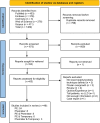Are percutaneous epiphysiodesis and Phemister technique effective in the treatment of leg-length discrepancy? A systematic review
- PMID: 38324644
- PMCID: PMC11444351
- DOI: 10.1097/BPB.0000000000001160
Are percutaneous epiphysiodesis and Phemister technique effective in the treatment of leg-length discrepancy? A systematic review
Abstract
Epiphysiodesis is considered the preferred treatment for children predicted to have leg length discrepancies (LLDs) 2-5 cm at maturity. The aim of this study was to systematically review the existing literature on the effectiveness of permanent epiphysiodesis for LLD treatment, and secondarily to address the reported complications of permanent epiphysiodesis techniques. This systematic review was performed according to PRISMA guidelines. We searched MEDLINE (PubMed), Embase, Cochrane Library, Web of Science and Scopus for studies on skeletally immature patients with LLD treated with permanent epiphysiodesis. The extracted outcome categories were effectiveness of epiphysiodesis (LLD measurements pre/post-operatively, successful/unsuccessful), physeal fusion/arrest, and complications that were graded on severity. Forty-nine studies (3051 patients) were included, 1550 underwent Phemister/modified Phemister epiphysiodesis and 1501 percutaneous epiphysiodesis (PE). Total successful permanent epiphysiodesis surgeries (16 studies) were 73.7% (516/700). Only 13 out of 23 studies had a mean final LLD of less than 1.5 cm. In total, 17.5% (513/2936) of complications were reported. 57 angular deformities were reported (1.9%). Phemister technique had higher percentage of complications (39%) than PE (19.1%) in total, but when failure to achieve adequate reduction in LLD was not included, complication rates for both were close to 14%. However, severe complications were 10.2% for Phemister group and 5.1% for PE. The high complication rates and the relative low success rate call for optimization of the timing and the applied techniques when treating LLD with permanent epiphysiodesis. Phemister technique was found to have higher percentage of severe complications than PE. Registration: PROSPERO (CRD42023435177).
Copyright © 2024 The Author(s). Published by Wolters Kluwer Health, Inc.
Conflict of interest statement
There are no conflicts of interest.
Figures
Similar articles
-
Staples, tension-band plates, and percutaneous epiphysiodesis screws used for leg-length discrepancy treatment: a systematic review and proportional meta-analysis.Acta Orthop. 2024 Jul 18;95:415-424. doi: 10.2340/17453674.2024.41104. Acta Orthop. 2024. PMID: 39023429 Free PMC article.
-
Comparison of three surgical epiphysiodesis techniques for the treatment of lower limb length discrepancy.Acta Orthop Belg. 2010 Apr;76(2):226-32. Acta Orthop Belg. 2010. PMID: 20503949
-
Leg length inequality and epiphysiodesis: review of 96 cases.J Pediatr Orthop. 2003 May-Jun;23(3):381-4. J Pediatr Orthop. 2003. PMID: 12724605
-
Growth arrest: leg length correction through temporary epiphysiodesis with a novel rigid staple (RigidTack).Bone Joint J. 2021 Aug;103-B(8):1428-1437. doi: 10.1302/0301-620X.103B8.BJJ-2020-1035.R4. Bone Joint J. 2021. PMID: 34334047 Free PMC article.
-
Assessment of Skeletal Maturity and Postoperative Growth Disturbance After Anterior Cruciate Ligament Reconstruction in Skeletally Immature Patients: A Systematic Review.Am J Sports Med. 2022 Apr;50(5):1430-1441. doi: 10.1177/03635465211008656. Epub 2021 May 13. Am J Sports Med. 2022. PMID: 33984243
Cited by
-
Staples, tension-band plates, and percutaneous epiphysiodesis screws used for leg-length discrepancy treatment: a systematic review and proportional meta-analysis.Acta Orthop. 2024 Jul 18;95:415-424. doi: 10.2340/17453674.2024.41104. Acta Orthop. 2024. PMID: 39023429 Free PMC article.
-
Updates in the Management of Leg Length Discrepancy: A Systematic Review.Cureus. 2024 Jun 18;16(6):e62599. doi: 10.7759/cureus.62599. eCollection 2024 Jun. Cureus. 2024. PMID: 39027766 Free PMC article. Review.
References
-
- Gross RH. Leg length discrepancy: how much is too much? Orthopedics 1978; 1:307–310. - PubMed
-
- Ruzbarsky JJ, Goodbody C, Dodwell E. Closing the growth plate: a review of indications and surgical options. Curr Opin Pediatr 2017; 29:80–86. - PubMed
-
- Friberg O. Clinical symptoms and biomechanics of lumbar spine and hip joint in leg length inequality. Spine (Phila Pa 1976) 1983; 8:643–651. - PubMed
Publication types
MeSH terms
LinkOut - more resources
Full Text Sources
Medical
Miscellaneous


